Home >
Matabeleland North >
Dr James Johnston’s account of a journey across Africa (Part 3 of 5 - From Sesheke to Bamangwato, including the Victoria Falls)
Dr James Johnston’s account of a journey across Africa (Part 3 of 5 - From Sesheke to Bamangwato, including the Victoria Falls)
31 January 1892. We made a long run today, from 7am until we reached Sesheke where Dr Livingstone had his headquarters while exploring in these regions. There is now here a station of the Paris Evangelical Mission, in charge of Monsieur and Madame Goy, who were expecting my arrival and tendered me a welcome so hearty that I felt very much at home right away.
Next morning the chief Nananwana and headmen assembled and much time was occupied in talking over the prospects of my journey beyond Kazungula as they have to find more carriers from me by order of Lewanika, for we are still in his territory. We will be delayed here a few days as the overland caravan has not yet turned up. I sent on the two Jamaicans in charge of the boats and goods to Kazungula as I find the spot where the camp is pitched very unhealthy and they are having constant fever.
9 February. The whole week has been spent at Shesheke waiting for the loads by land. They arrived yesterday afternoon with all the goods safe and I have made arrangements to start for Kazungula tomorrow. The work here, like most new missions in the interior, is discouraging in the extreme. For many months, Monsieur Goy has been building a meeting house that is at last complete. He went into the forest and cut the timber, loaded it on his wagon and brought it home. Then prepared the wood for the frame, put on the rafters and had the roof thatched. All with little help from local people.
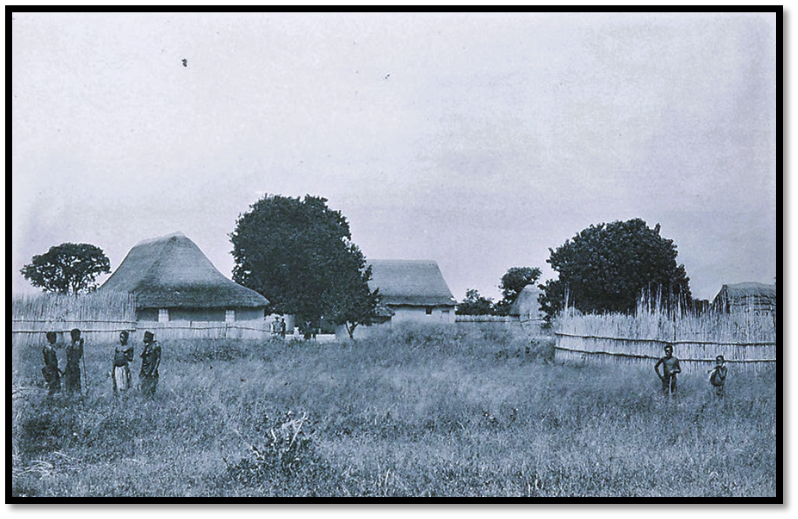
The mission station at Sesheke
Monsieur Goy proposed to have a formal opening and went around the villages inviting the people to come. About a hundred and fifty responded to the call as there was to be a roasted ox. But yesterday, there being nothing promised to eat, the service commenced with an audience consisting of the chief, five lads and four women.
He writes there is no difficulty in getting people who come round the station during the week to listen, even with apparent interest for hours together to spiritual counsel, but it would be a mistake to conclude that their assents and nods of approval are sincere. One young missionary in his innocence and zeal was so delighted with the long conversations he was having daily with three men posing as inquirers that it formed the subject of a very interesting letter he was writing to friends at home. But near the end of the week the trio lingering round the door to a later hour than usual were asked why they waited. The answer was prompt. “We are waiting for five days pay.” “Pay for what” queried the astonished missionry. “Well, now! Did you think we were coming here everyday to listen to you for nothing?”
Johnston concludes: never, until the present absolute power of the big chiefs over the body and soul of their vassals is broken (which, however, must come at no distant period) will there be any real success in spreading the gospel among them. The missionary is ever conscious that while he is speaking to the people before him, if they think at all, are debating in their own minds, “Were I to become a Christian, what would my chief say!” for well they know that the ethics of Christianity are condemnatory of the life, conduct and character of their rulers.
10 February. They say goodbye to their good friends at Sesheke and leave in a large canoe 10 metres ( 32 feet) long with five strong paddlers and hope to reach Kazangula 113 km (70 miles) away by evening. At midday at Mombova rapids, Johnston learns that two of the canoes sent ahead capsized, spilling their loads, but being mostly trade cloth, should dry off. Kazungula is reached by 3:30pm in eight hours travelling time.
Kazungula is another French Mission station and led by Monsieur and Madame Jalla, who greet him warmly. Here everyone who wishes to visit the Barotse valley, must cross the Zambesi. There is not a village or native hut within a mile of the mission and the site is very unhealthy as when the river floods, water rises to within a few yards of the mission house.
I found Frater and Jonathan, my two Jamaicans, comfortably settled in an old wagon with all the goods in a hut. Here I discharged the Barotse boatmen and waited for the carriers to take the loads on the next stage of the journey, over 100 are already in camp.
Today Jack, my interpreter tells me he needs more money although I'm paying him twice as much as he would normally earn, so I quietly told him I'll get along without him. Monsieur Jalla thought there might be prospects for mission work in the Batoka country and will travel with me as far as the Kafukwe (Kafue) river and he knows the Sesutu language well. Madame Jalla readily agrees to being alone for the next 3-4 months. The malaria is deadly to everyone and they have lost two young girls to it already and have a surviving son of 8 months.
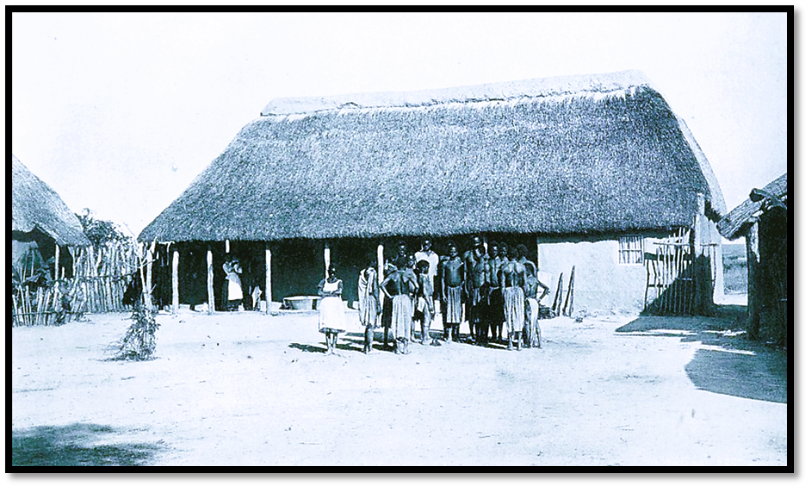
Kazungula mission station
16 February. There are now 150 men in camp, one-third being porters, the remainder warriors sent by Lewanika to escort us as far as the Kafue river. I have been busy all day allotting loads. There are rumours that an amaNdebele impi - the Matabele are feared by everyone - have crossed the Zambesi into Batokaland and are lying in wait for us.
18 February. All is ready for the march in the morning when the servant reports my camp is deserted. “The cowardly fellows had fled during the night, doubtless to relate to the king a story of the appalling dangers they have escaped. Well, better that they go here than later on, when I might have been in a worse fix. Thus, I am left alone again with my two Jamaicans. This is a crusher, but like the African fever, we get used to it.”
In the meantime, accompanied by Monsieur Jalla and a few porters to carry the blankets they set out on a week's tramp through Batoka to see the natives and visit Africa's greatest wonder, the Victoria Falls. We went by canoe as far as the Nanpwi rapids, where we hid the boat and took a footpath along the riverbank to a small village that we reached at 6pm and camped under a large tree, but were almost eaten alive by mosquitoes.
We left at daylight, but our native guide became lost and we took our own path before camping for the night.
Next day we left early and by midday reached the village of the chief at the drift about a mile above the falls, who tries to hold a monopoly of ferrying visitors across the river. Despite being offered pay, he only remarked “that he would think about it and see us tomorrow.” Resenting this idea, Monsieur Jalla interviewed another chief, an old Makalolo named Mosatane who treated us with much more respect, gave us a sheep and plenty of mealie meal and promised to see us over in the morning.
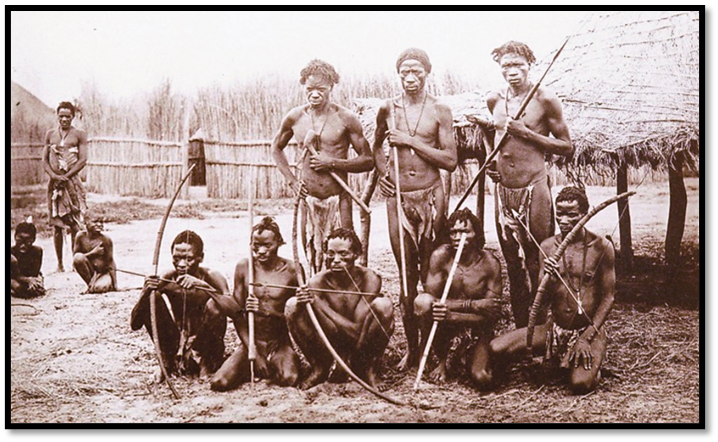
Batoka tribesmen
The river is about a mile wide and broken up by large islands of from 150 to 200 yards across, these islands are covered with the most tropical looking vegetation we had seen. Looking down the river, we see five columns of spray, white as snow, rising slowly high above the falls and lingering in clouds that glisten beautifully in the sunlight. Early in the morning, Mosatane appeared with the canoes and paddled us over to the west bank, where the falls can be seen to the best advantage. Half an hour’s walk brought us close to the renowned cataract, Mosia-ua-tunia (Lozi: Mosi-oa-Tunya, "The Smoke That Thunders”) Victoria Falls, as Livingstone named them.
The Victoria Falls
In the afternoon we went to view the attraction that had induced us to walk fifty rough and weary miles. The banks are densely wooded with huge trees and thick underbrush. When within a stone’s-throw of the water we entered an atmosphere of perpetual drizzle, kept up
by the spray that rises unceasingly in great volumes and is carried in the direction of the wind, to fall as fine rain. The ground is sopping wet; every now and then we sink to the ankles in mud and in a few minutes are drenched through. Yet for hours we stand gazing in amazement and awe, contemplating this the greatest natural phenomenon we have ever seen. Now we are on the edge of the chasm; but it is impossible, with either pen or pencil or camera, to give anything like an adequate idea of the majestic splendour of this rival of Niagara.
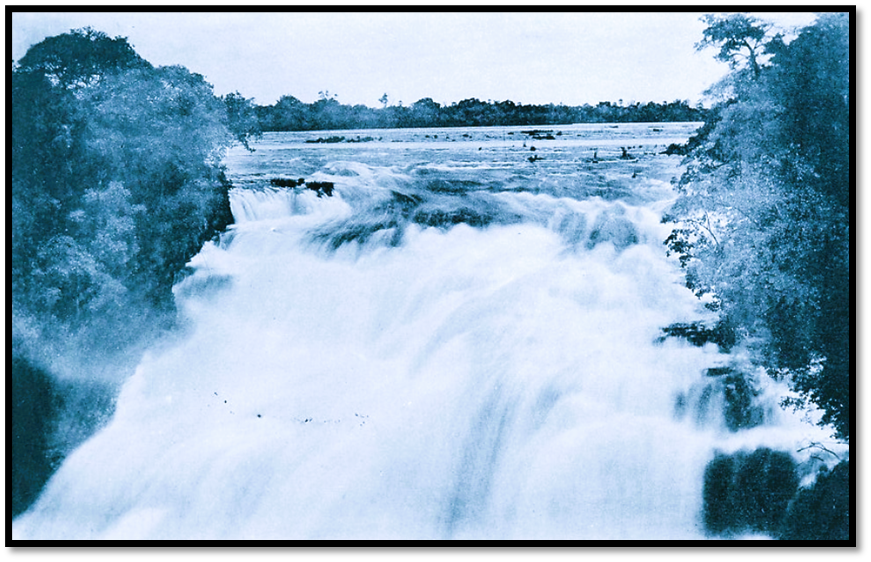
The Western Cataract (Zimbabwe bank) of the Victoria Falls
The river is about a mile broad as it dashes over a precipice four hundred feet in depth, in a straight line across its entire width. The chasm into which the river plunges is a narrow rent not more than a hundred and fifty feet wide, and runs at right angles to its course, getting narrower toward the eastern bank. The opposite side of the fissure is very precipitous,
of hard basaltic rock, and almost on a level with the river above; but on account of the dense fog one cannot see more than a couple of hundred yards at a time, and that only when a gust of wind blows it to one side, which, though momentary, bears repeating many times
over, and well repays the exercise of patience, for through these rifts we get a magnificent view of the lovely blue water above flowing calmly and tranquilly onward until it crashes into the seething abyss below. The palm-bearing islands in the distance form a picturesque background to the sublimely beautiful scene. While viewed in sunshine the double zones of prismatic colours formed in the spray have a brilliancy compared with which an ordinary rainbow is but a faint semblance. Livingstone, Baines and Mohr have each in turn given their impressions of the Victoria Falls.
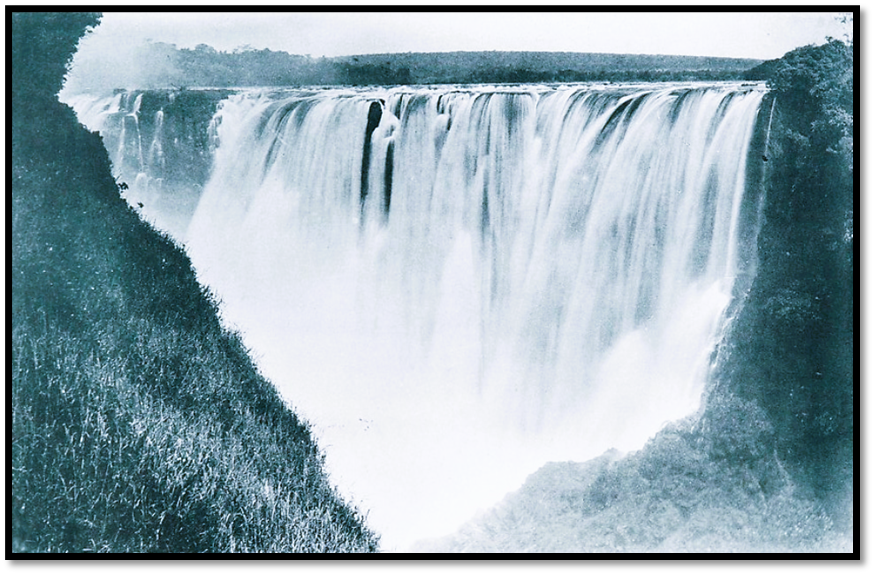
The main falls with Zimbabwe bank on the left, Zambian bank on the right
He then give Mohr’s impressions which I have not repeated along with his attempts to define longitude and the various heights.
After the Zambesi has made its way through the pass, two hundred and seventy feet wide, it rolls on in sinuous fashion, describing three or four wide curves. The bed is so narrow that its depth must be enormous to accommodate such a vast volume of water. The banks consist of perpendicular rocks five hundred or six hundred feet high, absolutely inaccessible to men,though many baboons, which have taken up their abode here, climb up and down them with ease.
I have to apologize for the accompanying photographic views of the falls, as they by no means convey the impression of grandeur produced on an eye-witness.[i]
On the 24th I walked down as far as the first bend, about a mile and a half distant. This turn is most abrupt, the gorge narrow, and the water very deep, the surface streaked with foam. The left of the ‘Profile Cliff’ photo represents the eastern extremity of the falls, where the waters leave the narrow chasm and continue their course toward the Indian Ocean. While returning to camp I came across a lot of baboons the size of eight year old boys, but being alone, gave them a wide berth.
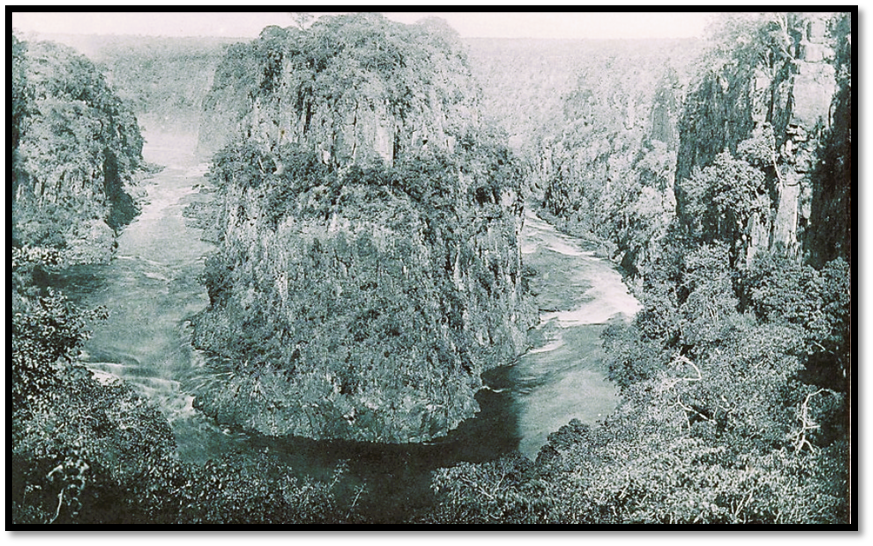
Zambezi river below the Victoria Falls – ‘Profile cliff’ photo
On the 25th, though loath to leave this enchanting spot, we rolled up our blankets and silently stole away; but not while my pulse beats shall I forget the experience of these three days. Mosatane was on hand to ferry us over and invited us to his village to see his people. We followed him and under a big tree in the vicinity of his compound set about preparing breakfast.
Mosatane reveres the name of David Livingstone, with whom he made many long journeys and tells numerous stories concerning him, but all in the highest praise of the great explorer. At Sesheke we met two old men Makumba and Ratan, who also claimed to have been in the service of Livingstone, they vied with each other in extolling his character and apparently recalled the memory of the years spent in his service with great pleasure.
The party took two days to get back to Kazangula although Johnston was now suffering from fever – probably malaria, as he complains again about the mosquitoes.
28 February. I feel very much better, only that the twenty-five to thirty-grain doses of quinine make my ears ring unpleasantly and I can hear nothing else.
This website has an article on early visitors to the Victoria Falls called The first European Visitors to view the Victoria Falls before the end of 1880 under Matabeleland North.
I crossed the river to the west bank to interview two English hunters who are waiting for an answer from Lewanika to their request for permission to hunt elephants in his country. I found them very short of trade stuff of which I have a good supply. They have a bullock-cart and oxen with two Cape Colony drivers, whom I had the option of engaging, business was speedily arranged to our mutual satisfaction, and thus most unexpectedly, ways and means for transport are once more provided. The oxen are kept some ten miles distant from here, beyond the “fly” belt that skirts the west bank of the Zambezi and they can only come in here at night, when the tsetse is supposed not to bite. They are sent for and will be here by 10 o’clock when I load up and start without delay.
My goods are already across the drift before I wish Monsieur and Madame Jalla goodbye; they have been very kind to me. We start at 11pm hoping to be beyond the “fly” by daylight.
We reach Leshuma next morning where the twelve oxen that will drive the cart are inspanned. The Coillard’s had to wait here for over a year to get Lewanika’s permission to enter the Barotse Valley. Near Leshuma is the solitary grave of a Swede named Oswald Bagger, who died of fever in 1878; Johnston describes the country as lonely, wild and dreary. They trek until 9pm before camping.
Leshuma to Pandamatenga
They reach Pandamatenga and take on an extra span of oxen. The Jesuits established a mission here because having entered the Barotse Valley without Lewanika’s permission, he ordered them out. George Westbeech, the trader, had made the site his trading base and the Jesuits built a dwelling house and Church, but since they have left, the Church is now a stable. Their mission was a failure; one of the brothers died, a Father drowned on his way to the Barotse Valley and the others became disheartened and fell ill with fever. George Westbeech is now dead, his trading store abandoned, the current occupiers being two mixed-race and San hunters. They saw five heaps of stones, being the graves of Jolly, Cowley, Bairn, Baldwin and Lowe, all who succumbed to malaria fever. See the article on this website called George ‘Joros’ Westbeech’s influence in the lower Zambesi Valley and his 1885-1888 diaries under Matabeleland north.
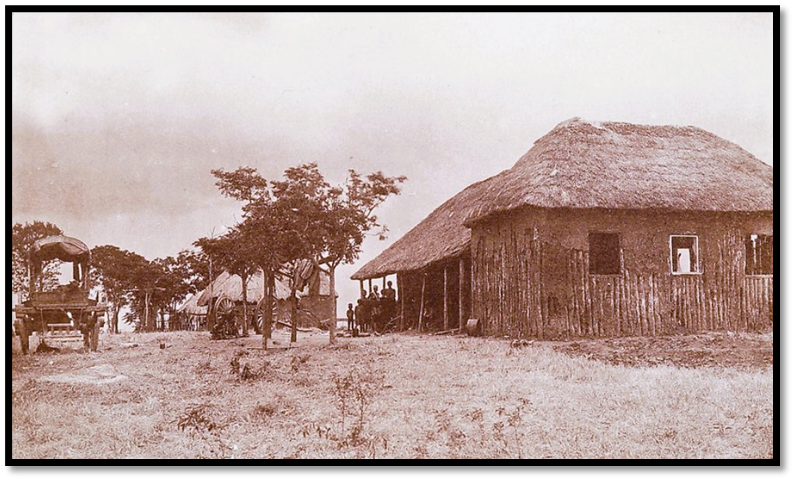
A rare photo of Pandamatenga in 1892
5 March. We leave Pandamatenga early for three days journey through rough country of either rocky belts of woodland with enough stones and stumps to almost shake the cart to pieces, or miles of swamp with black mud to the axles. A fierce case of fever came on and I was sitting on the cart holding my aching head between my hands when the disselboom of the cart gave way.[ii] We camped where we were, but by now the fever had me in its grip.
This continued the next day with vomiting and shaking that I had seen in others, but never experienced personally. By evening the drivers had cut a new disselboom and I was able to crawl into the cart and for the next two dayscould only drink some brackish and muddy water.
12 March. Today feeling much better. Lions roared and growled last night within fifty paces of the wagon with no rest for the drivers and myself, as we had to keep guard, rifle in hand, against our oxen being attacked. We met three wagons going to the Zambesi with supplies for the missionaries. Their cnductor said the lions, in spite of big fires, dogs and guns had attacked their oxen, wounding one so badly it was killed along with one of their dogs.
Trekking routine
An hour before sunrise the fire is made up and the kettle put on, blankets are stored away with cooking utensils and the waterkeg ‘voige’ filled up if they are near a vlei. The cattle are inspanned and coffee and some bread baked in the ashes quickly eaten. The driver’s long whips crack; ‘trek’ is shouted and the oxen pull the wagon for five or six hours through deep sand, rocky or swampy ground, belts of mopane forest or thorn scrub. If water is reached by 10am, they will outspan and rest during the heat of the day before inspanning again at 3 - 4pm and trekking until 9pm when they camp for the night. The oxen are tied to the trek-chain with reims and the men sleep under the starry sky.
At times there is no water to be found for the men or the oxen, necessitating long dry treks. At one time they were three days without water, but at last saw a small lake in the distance. The oxen scented water and pushed on faster, but when they reached the lake an hour later found it was a salt pan and the water brackish. Fortunately two hours later they came on a deep well with several feet of muddy water that could be drawn out by bucket.
There they rested 24 hours to give the oxen time to recover. Two oxen with lung sickness had been left to follow along behind. One fell prey to lions, the other was shot.
Johnston describes an encounter with a San hunter who came into their camp for some salt. While trying to talk with him through one of the drivers he suddenly held up his hand and motioned us to be silent. Then he slung the quiver with his arrows over his shoulder and grasping his tiny bow glided off swiftly into the grass in a stooping posture. We then spotted the heads and necks of two giraffe. In a very short time the hunter got within a few yards of them and fitted an arrow and aimed at and hit the larger of the two giraffes. It gave a frightened jump and then walked leisurely away and the hunter returned to us. When we asked him why he did not follow up the giraffe he said: “Why should I drive the meat away, it will not go far.” Nor was his confidence mistaken, as proved by the excellent giraffe steaks we had for breakfast next day.
His primitive bow and small bark quiver of cane arrows with their detachable ivory, poisoned points were exchanged for a teacup of salt and three yards of cloth and are now in my collection.
Notes
[i] The website to the victoria falls states the some of the earliest surviving photos of the Victoria Falls were taken by Frank Watson in 1891 (https://www.tothevictoriafalls.com/vfpages/discovery/firstphotos.html) If so, the photographs by Dr James Johnston in 1892 are amongst the earliest surviving photos.
[ii] A mix of Afrikaanse dissel “support pole” and boom “tree, beam”
When to visit:
n/a
Fee:
n/a
Category:
Province:
